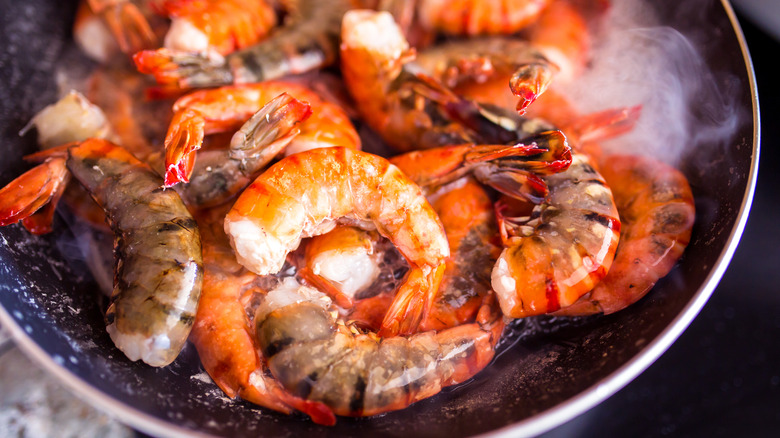Hey there. seafood lovers! Ever wondered why those grey kinda dull-looking raw shrimp transform into beautiful orange beauties when they hit the heat? Well I’ve done some deep diving into the science behind this cool color change. and I’m excited to share what I’ve learned with you all!
The Quick Answer
The short answer? It’s all thanks to a pigment called astaxanthin. But don’t worry if you can’t pronounce that – we’re gonna break it down in simple terms!
The Color-Changing Magic Explained
The Raw State
When shrimp are raw, they’ve got this not-so-appetizing bluish-grey color Here’s what’s actually happening
- Raw shrimp contain proteins called crustacyanin
- These proteins hide the orange-red astaxanthin pigment
- The crustacyanin forms a protein chain that wraps around the astaxanthin
- This protein coating is what gives raw shrimp their greyish appearance
The Cooking Transformation
When we toss those shrimp into a hot pan or boiling water, something pretty amazing happens:
- Heat breaks down the crustacyanin proteins
- As these proteins unravel, they release their hold on the astaxanthin
- The hidden orange-red pigment finally gets to show off its true colors
- And voila! We get those gorgeous orange shrimp we all love
How to Use Color as Your Cooking Guide
I’ve cooked thousands of shrimp (okay, maybe hundreds), and here’s my foolproof guide to using color as your cooking indicator:
- Raw Stage: Blue-grey, translucent, and kinda limp
- Partially Cooked: Starting to turn pink but still some grey spots
- Perfectly Cooked:
- Completely opaque
- Bright orange-pink all over
- Nice C-shape curve
- Internal temp of 145°F (use a thermometer if you’re unsure!)
Fun Facts About Astaxanthin
Did ya know that this color-changing compound isn’t just for show? Here’s some cool stuff about astaxanthin:
- It’s the same pigment that makes salmon and lobsters orange
- You’ll find it in algae too
- It’s actually a super powerful antioxidant
- The highest concentration is in the shells and heads (which most of us throw away!)
Pro Tips for Better Shrimp Cooking
Here’s what I’ve learned from my kitchen experiments:
-
Shell-On Cooking
- Try cooking shrimp with shells on
- You’ll get more flavor this way
- Plus, more of those healthy antioxidants
-
Don’t Waste Those Tails
- Believe it or not, shrimp tails are edible
- They’ve got lots of that good astaxanthin
- Great way to reduce food waste
Health Benefits You Didn’t Know About
The astaxanthin in shrimp isn’t just responsible for that pretty color – it’s actually good for you too! Check out these benefits:
- Supports immune system function
- Helps protect your skin from UV damage
- Contributes to heart health
- Acts as a powerful antioxidant
Common Questions About Shrimp Color Changes
Why do some shrimp look more orange than others?
The intensity of the color can vary depending on:
- The type of shrimp
- Their diet before being caught
- How they were stored
- Cooking temperature and method
Is it safe to eat shrimp that hasn’t turned completely orange?
Nope! Always make sure your shrimp are fully cooked until they’re completely opaque and orange-pink. When in doubt, use that thermometer!
The Bottom Line
The next time you’re cooking up some shrimp and watch that magical color transformation happen, you’ll know exactly what’s going on! It’s pretty amazing how nature packed these little creatures with a pigment that not only makes them look appetizing when cooked but is also super good for us.
Remember, that color change isn’t just for show – it’s your built-in cooking timer telling you when your shrimp are ready to eat. And now that you know all about astaxanthin and its benefits, maybe you’ll think twice before tossing those shells and tails!
P.S. Don’t forget to share this article with your seafood-loving friends who might be curious about the science behind their favorite shellfish!

What is astaxanthin and how does it affect the color of shrimp?

Astaxanthin is a xanthophyll carotenoid, a naturally-occurring pigment that is insoluble in water. It is transmitted into shellfish like shrimp and lobster through the organisms food that it consumes in its aquatic environment. Located in the shrimps exoskeleton, this orange-red molecule is concealed by the aforementioned protein chains called crustacyanin. However, once exposed to high heat — say, in a pot of boiling water — the heat-unstable crustacyanin is destabilized and can no longer hold together, allowing us to see the red hues of the astaxanthin.
Beyond offering a pretty appearance to cooked shrimp, lobster, and an assortment of other organisms, astaxanthin is a powerful antioxidant with several potential health benefits. These include (but are not limited to) supporting the immune system, protecting your skin from UV damage, and contributing to heart health. While we do consume some astaxanthin in the flesh of shrimp, the highest concentrations of the pigment are found in the shells and head — which are usually discarded rather than eaten, in some cultures. If youre looking to get just a smidge of extra antioxidants in your meal, try cooking your shrimp with the shells and heads on — many chefs even say that shell-on shrimp retain more flavor.
